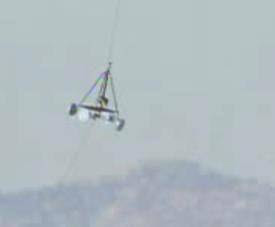

Picture caption: An earlier picture of the laser motive climber. Mostly solar cells that absorb the laser light that power a motor that climbs the cable. On the right is a screenshot of Lasermotive’s climber from the ustream video
3:00:39 PM PST:
LaserMotive Climber is climbing! Live at http://ustre.am/4mZA
3:10:58 PST:
First climb was 4 minutes, 2 seconds – officially. They qualified for the $900K prize. Live at http://ustre.am/4mZA
3:11:11 PST:
Now trying a second climb Live at http://ustre.am/4mZA
3:12:48 PST:
Second climb completed – unofficially also 4:00 or so. These guys HAVE to be happy… Live at http://ustre.am/4mZA
If neither the University of Saskatchewan or the Kansas City Space Pirates can beat that time over the next few days then Laser Motive will win the prize.
But in 2009 there will be a winner of the laser beaming space elevator contest.
See the live updates for more runs tomorrow and Friday and to review todays competition

Picture caption:The bottom of the 1000 meter (1100 yard) cable that is suspended from a helicopter.
Youtube Video of the Actual Climb
(H/T to reader Jriskin)
Power beaming prize description and rules page.
Vertical Distance: 1 km
Speed: 2 m/s, 5 m/s
Prize Purses:
$900,000 for 2-4.99 meters/second
$1.1 Million for 5+ meters/second
Lasermotive’s climber went 1000 meters in 242 seconds is about 4.13 meters/second
A climb faster than 3 minutes and 20 seconds is needed to win the 5 meter per second prize for $1.1 million.
LaserMotive (Tuesday, Nov 3, 2009) beamed roughly 400 watts of laser power to a moving target at a distance of 1 kilometer, as part of the vertical laser alignment procedure. The target was a retro-reflective board a little larger than 1 meter on a side. I don’t know offhand if that is a record; I will have to check once things calm down. (It’s a record that will likely be broken tomorrow by one or more teams, of course.)
Summarizing Space Elevator Feasibility Articles
For a Carbon Nanotube tether that is 30 MYuri [A MYuri is the name we gave the SI equivalent of N/Tex, or GPa-cc/g] strong, and a characteristic time constant (CTC) of 1 year the Feasibility Condition requires that the climbers will have a power density of at least 1.0 kiloWatt/kg.
So where do the competition requirements stand in respect to this?
It is easy to show that when moving straight up, the power density of the climber is directly proportional to its speed (mgv/m), and so a 5 m/s speed in 1 g gravity corresponds to 50 Watt/kg, or about 5% of a real commercial scale Space Elevator climber.
The Space Elevator will function a lot better with a ~35 MYuri material, but this is the bare minimum that we need. Keep in mind that successive 50% improvements in material strength are very large steps, but that we already know that CNT molecules are measured at ~50 MYuri, and fabricated CNT micro-bundles have been produced by several labs at 10 MYuri, so this challenge is not impossible.

Achieving higher speeds and power density for the climber seems more likely than achieving stronger tethers.

Brian Wang is a Futurist Thought Leader and a popular Science blogger with 1 million readers per month. His blog Nextbigfuture.com is ranked #1 Science News Blog. It covers many disruptive technology and trends including Space, Robotics, Artificial Intelligence, Medicine, Anti-aging Biotechnology, and Nanotechnology.
Known for identifying cutting edge technologies, he is currently a Co-Founder of a startup and fundraiser for high potential early-stage companies. He is the Head of Research for Allocations for deep technology investments and an Angel Investor at Space Angels.
A frequent speaker at corporations, he has been a TEDx speaker, a Singularity University speaker and guest at numerous interviews for radio and podcasts. He is open to public speaking and advising engagements.

